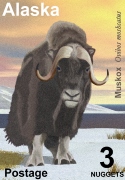Click on image for larger view.
The taiga, also known as the boreal forest and characterized by coniferous forests, is the world’s largest terrestrial biome and covers in North America most of inland Canada and Alaska. Much of Siberia is taiga as are areas of northern Europe. Large population centers, such as Moscow and Toronto, can be found in the southern portion of this biome, but the northern portion is largely unpopulated.
Temperatures vary greatly between winter and summer seasons. Winters are long and cold, and the summers are short and cool. Precipitation is moderately high throughout the year with snow occurring during the winter months.
Most of the taiga in North America was once covered with glaciers that have receded, leaving gouges and depressions in the topography. Since there is moderately high precipitation, these gouges and depressions are frequently filled with water, creating bogs and lakes. The soil found in the taiga is low in nutrients and high in acid. It also is rocky and covered with undecayed leaf litter. Patches of permafrost can also be found in areas of the taiga.
The taiga has far fewer plant and animal species than the tropical or the deciduous forest biomes. Specoas of spruce (Picea), fir (Abies), and pine (Pinus), and the deciduous larch or tamarack (Larix). In North America, one or two species of fir and one or two species of spruce are dominant. Across Scandanavia and western Russia the Scots pine is a common component of the taiga. Alder (Alnus), birch (Betula), and aspen (Populus) are also common.
Fur-bearing predators such as lynx and various members of the weasel family (e.g., wolverine, fisher, pine martin, mink, ermine, and sable) are characteristic of the boreal forest proper. The mammalian herbivores on which they feed include the snowshoe or varying hare, red squirrel, lemmings, and voles.
Large herbivores, hunted by wolves, are closely associated with successional stages where there is more nutritious browse available and include elk or wapiti (Cervus elaphus, known as red deer in Europe) and moose (Alces alces, known as elk in Europe). The beaver (Castor canadensis), on which the early North American fur trade was based, is also a creature of early successional communities, indeed its dams along streams create such habitats.
Among birds, insect-eaters like the wood warblers are migratory and leave after the breeding season. Seed-eaters (e.g., finches and sparrows) and omnivores (e.g., ravens) tend to be year-round residents. During poor cone years, normal residents like the evening grosbeak, pine siskin, and red crossbill leave the taiga in winter.

















Thanks for the lovely picture. I can almost feel the cold and smell the trees. Also enjoyed the facts about the wildlife.
Hey!Shirley….your comment is too nice……..its too nice Bye………….
That being the case, I have done my job.